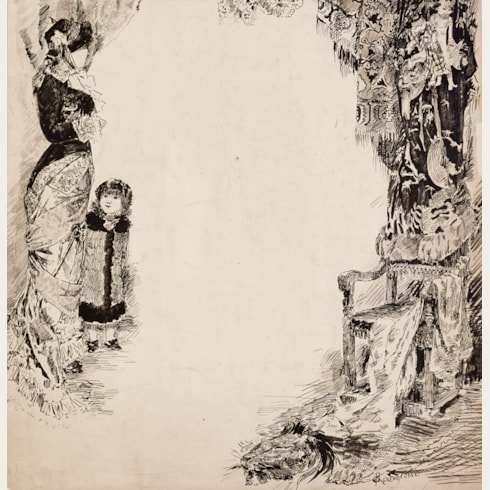Georges Antoine ROCHEGROSSE
(Versailles 1859 - El-Biar, Algiers 1938)
‘Vater Rhein’: An Allegory of the River Rhine
Watercolour over a pencil underdrawing.
Inscribed Vater Rhein in pencil at the lower left.
126 x 282 mm. (5 x 11 1/8 in.)
Inscribed Vater Rhein in pencil at the lower left.
126 x 282 mm. (5 x 11 1/8 in.)
‘Vater Rhein’ or ‘Rhenus Pater’ (‘Father Rhine’) is the personification or river god of the Rhine river, and was usually depicted as an old, bearded man.
Abandoned by his father as a child, Georges Rochegrosse was the stepspon of the poet and writer Théodore de Banville. He was a pupil of Alfred Dehodencq before entering the Académie Julian at the age of twelve, studying there with Jules Lefebvre and Gustave Boulanger. He later enrolled in the Ecole des Beaux-Arts, where he was twice a finalist in the competition for the Prix de Rome. Rochegrosse made his debut at the Salon de la Société des Artistes Français in 1882, winning a third-class medal for his painting of Vitellius Dragged Through the Streets of Rome by the Populace, while at the Salon the following year his painting of Andromache was purchased by the State for the Musée de Rouen. His earliest exhibited works tended towards scenes from literature, legend and scenes from Egyptian, Roman and Byzantine history, often tinged with violence, seen in such paintings as The Madness of King Nebuchadnezzar and The Death of Caesar, shown at the Salons of 1886 and 1887, respectively. The 1890s found Rochegrosse working in a more Symbolist vein, exemplified by his large painting The Knight of the Flowers, inspired by Wagnerian mythology. Nearly four metres long, the painting was first exhibited at the Internationale Kunstaustellung in Munich in 1892 and two years later at the Salon des Artistes Français in Paris, where it was acquired by the State; it is today in the Musée d’Orsay. In 1898 Rochegrosse decorated the staircase of the library of the Sorbonne with a mural of The Song of the Muses Awakening the Soul, one of several commissions for public decorations that the artist received; another such project was the decoration of the Salle des Fêtes for the Paris Exposition Universelle of 1900.
By the turn of the century, however, Rochegrosse had come to be best known as a fashionable painter of Orientalist and mythological subjects, finding inspiration for much of his work in his travels throughout North Africa. From 1900 onwards the artist spent the winter months in Algeria, where he maintained a studio in El-Biar, a suburb of Algiers. He also frequently exhibited at the Salon des Artistes Algériens et Orientalistes and at the Union Artistique de l’Afrique du Nord. By the end of the first decade of the 20th century Rochegrosse was seen as one of the leading exponents of Orientalism in France, exhibiting his work at the annual Salons, as well as at the Salon des Peintures Orientalistes Français.
Rochegrosse grew up in a literary and artistic milieu. From an early age he made drawings that were reproduced in the journal La Vie Moderne, and his work continued to be featured in magazines throughout his career, particularly from the 1890s onwards. His friendships with writers and poets also meant that he was often asked to illustrate their books, and he produced drawings for Gustave Flaubert’s Salammbô, Victor Hugo’s Les Misérables and Charles Baudelaire’s Les Fleurs du Mal, as well as books by his stepfather Théodore de Banville, Anatole France, Théophile Gautier, Pierre Louys and several other writers. The artist’s original drawings for these illustrations were often exhibited at the Galerie Georges Petit in Paris and at the Salons de la Société des Aquarellistes Français. Rochegrosse also produced designs for posters, theatrical productions and Gobelins tapestries.
By the turn of the century, however, Rochegrosse had come to be best known as a fashionable painter of Orientalist and mythological subjects, finding inspiration for much of his work in his travels throughout North Africa. From 1900 onwards the artist spent the winter months in Algeria, where he maintained a studio in El-Biar, a suburb of Algiers. He also frequently exhibited at the Salon des Artistes Algériens et Orientalistes and at the Union Artistique de l’Afrique du Nord. By the end of the first decade of the 20th century Rochegrosse was seen as one of the leading exponents of Orientalism in France, exhibiting his work at the annual Salons, as well as at the Salon des Peintures Orientalistes Français.
Rochegrosse grew up in a literary and artistic milieu. From an early age he made drawings that were reproduced in the journal La Vie Moderne, and his work continued to be featured in magazines throughout his career, particularly from the 1890s onwards. His friendships with writers and poets also meant that he was often asked to illustrate their books, and he produced drawings for Gustave Flaubert’s Salammbô, Victor Hugo’s Les Misérables and Charles Baudelaire’s Les Fleurs du Mal, as well as books by his stepfather Théodore de Banville, Anatole France, Théophile Gautier, Pierre Louys and several other writers. The artist’s original drawings for these illustrations were often exhibited at the Galerie Georges Petit in Paris and at the Salons de la Société des Aquarellistes Français. Rochegrosse also produced designs for posters, theatrical productions and Gobelins tapestries.
Provenance
Rochegrosse studio sale (‘Vente fond d’atelier G. A. Rochegrosse’), Toulouse, Marambat de Malafosse, 7 November 2019, lot 47
Private collection, Paris.
Private collection, Paris.








